The Internet of Nature: How technology could shape our urban forests of the future
Dr. Nadina Galle and her work with the Internet of Nature uses technology to shape the future of the urban forest. The Canadian born former Fulbright scholar and MIT researcher now at the University of Amsterdam uses ground sensors and satellite imagery among other technologies to help cities monitor, care for and protect the urban forest to provide a better place for people to live in future.
New book, Nature of Our Cities, celebrates optimism in the midst of a changing planet
Dr. Nadina Galle may have got her “eureka moment” at the age of 12, but it took the release of her first book, The Nature of Our Cities, in June, 2024 to bring the “moment” into focus.
Terrified, at age 12, after watching a Canadian documentary called The End of Suburbia, she worried that the lifestyle she enjoyed growing up in a Canadian suburb in Waterloo, Ont., would eventually lead to the “collapse of the society (she) was born into.”
She remembers a happy childhood playing with her friends in their big, grass-filled backyards. It was a lifestyle, however, that even at an early age, she realized had its flaws.
“At the age of 12, I decided it would become my life’s mission to build better places for people to live,” Dr. Galle explains in her highly entertaining and informative TEDx talk.
“Gardeners, more than anyone, understand the intimate relationship between people and nature. This book offers them new, exciting tools—from AI-powered sensors that water newly planted seedlings to intelligent water gardens that mitigate floods—that can help anyone get involved in transforming where they live into resilient, vibrant ecosystems”
“Born in the Netherlands and raised in Canada, I developed my love for the outdoors and my commitment to conserving nature from a young age. Reading works by Jane Jacobs and James Howard Kunstler as a teenager, I questioned the imbalance between nature and the encroaching urban sprawl I saw around me in suburban Canada,” explains the former Fulbright scholar and MIT researcher.
Dr. Nadina Galle is at the forefront of using smart technology to protect the urban forest.
Today, Dr. Galle is working at the forefront of smart nature-based solutions, exploring how technology can transform the way we care for our natural urban environment. Her website The Internet of Nature is a treasure trove of information about how technology can benefit the urban forest including links to her cutting-edge podcasts.
“At the age of 12. I decided it would become my life’s mission to build better places for people to live.”
On her quest to build better places for people to live, she studied ecology, evolutionary biology, earth sciences, and eventually went on to earn a PhD in Ecological Engineering. In her fascinating TEDx Talk, she defines Ecological Engineering as the “design of sustainable ecosystems that integrate human society with its natural environment for the benefit of both.”
Remember that inquisitive, yet terrified little 12-year-old girl’s promise to herself?
Well, her lifelong pursuit of learning eventually led her to her PhD in Ecological Engineering at MIT and University College Dublin and what has emerged is what she calls “Internet of Nature.”
If that is not enough, Dr. Galle has just released her first book: The Nature of our Cities, Harnessing the Power of The Natural World to Survive a Changing Planet.
The 304-page book explores how innovators from around the world are combining urban nature with emerging technologies, to protect the planet’s cities from the effects of climate change and safeguarding the health of their inhabitants.
Dr. Galle explains in the book’s promotional material: We live in an age when humanity spends 90% of its time indoors, yet the nature around us—especially in America’s cities—has never been more vital. This distancing from nature has sparked crises in mental health, longevity, and hope for the next generation, while also heightening the risks we face from historic floods, heatwaves, and wildfires. Indeed, embracing nature holds untapped potential to strengthen and fortify our cities, suburbs, and towns, providing solutions spanning flood preparation, wildfire management, and promoting longevity. As ecological engineer Dr. Galle argues, nature is our most critical infrastructure for tackling the climate crisis. It just needs a little help.
What does all this mean to us urban and rural woodland gardeners?
Dr. Galle says Ferns & Feathers readers will appreciate her book on a number of levels.
“Gardeners, more than anyone, understand the intimate relationship between people and nature. This book offers them new, exciting tools—from AI-powered sensors that water newly planted seedlings to intelligent water gardens that mitigate floods—that can help anyone get involved in transforming where they live into resilient, vibrant ecosystems,” Dr. Galle told me.
• To order a copy of Dr. Galle’s book from Amazon, go here.
How gardeners can help protect the urban forest?
What does all this mean to the average woodland/wildlife gardener, or simply the urban homeowner living with a typical yard?
It means that although we gardeners may think of our gardens as ours alone to enjoy and experience, they are actually part of a much larger environment that makes up the urban forest – a forest that in most urban areas around the globe is under severe threat from natural (climate change) and human intervention.
Irish garden designer and author Mary Reynolds promotes this approach to natural gardening in her book The Garden Awakening where she advocates for homeowners to consider their properties like “natural arks” that form smaller islands of nature that can join together to provide much larger islands of native plants, trees and natural environments. (You can explore her approach further in my article about her work here).
This approach to urban gardening also means that traditional thinking probably has to change to ensure that our urban forests provide us with the natural environment so many of us depend on for our future well being. If the Covid-19 pandemic has taught us anything, it has made us more aware of the importance of green spaces and the natural environment to our own well being.
Protecting the urban forest has never been more important
The very fact trees sequester carbon is reason enough to plant as many new trees as possible. However, it’s been proven that older, existing trees (and their soils!) are even more effective at sequestering carbon, so ensuring their protection and continued health in our urban areas is vitally important.
Every year the urban forest is under greater threat, Dr. Galle explains in her TEDx Talk. This is hammered home by the fact that every week approximately 3 million people move (or are forced to move) to cities around the globe.
“Everyone is talking about how many people are moving to cities, but no one is talking about what kind of life they will live once they move there,” she explains.
How we protect the urban forest in the future is what Dr. Galle wants to change, and she wants technology to be leading the way. (More on that later in the article. First it’s important to understand our role as gardeners and homeowners in the whole process.)
“Roughly 50-70 per cent of the urban forest in any given city is on private/homeowner land, which means only 30-50 per cent is actually in the maintenance area of the city,” Dr. Galle explains via email to Ferns & Feathers from her home in the Netherlands.
“This is crucial because it shows the massive role homeowners can have in the development and longevity of the urban forest.”
An important point author Peter Wohlleben makes in his NYT best selling book The Hidden Life of Trees, (link to an earlier article on the book) and one that Dr. Galle echoes in her writings and talks, is that a tree planted in the heart of an urban landscape has a typical lifespan of a mere 7-30 years. The same tree planted in a natural forest can easily live to 100 years and considerably more given the right conditions.
Dr. Galle has even identified Wohlleben and the UBC forest ecologist, Dr. Suzanne Simard, whom he covers extensively in his book, The Hidden Life of Trees, as a major influence in her work, particularly research on how trees communicate through underground fungi that can connect to the roots of other trees (and plants) to create what’s called a mycorrhizal network. A mycorrhizal network can influence the survival, growth, health, and behavior of the trees linked within its extensive network or community. Trees use their network to not only communicate, but to share resources, often stemming from the resources of the “Mother Tree”, the most connected tree in the network.
This underground network, Dr. Galle emphasizes, needs to not only be protected through proper watering, fertilization and care, but encouraged to branch out in urban environments whenever possible. Success will depend on a multitude of factors including the cooperation of individual homeowners to protect the trees on their properties.
How valuable is a single tree on your property?
In fact, in his follow-up book The Heartbeat of Trees, Wohlleben gives an example of how a study conducted by Chicago University researchers found that a single tree planted on the lawn of an urban property can increase the benefits to the homeowner by the equivalent of an annual pay increase of $10,000. The study, conducted with thousands of Toronto, Canada residents, also showed that two trees planted in the front could provide the health and well-being benefits equal to an annual income increase of $20,000.
If this doesn’t convince homeowners of the importance of maintaining their own trees in their front yards, it’s hard to imagine what will.
“Most homeowners don’t realize the trees on their land (may be) protected by a private tree ordinance, meaning you can only cut down trees (even when you own the land!) with a permit,” Dr. Galle explains. “Otherwise, you can be fined, or even jailed (though I doubt that’s ever happened).”
“Many cities, like Santa Monica, for example,currently don’t have private tree ordinances, but after remote sensing analysis revealed they’d lost 20-30 per cent canopy cover on private residences in just a few short years, they’re rapidly trying to instate a private tree ordinance. Otherwise, there will be no urban forest left!" says Dr. Galle. (Readers can learn more about Santa Monica’s urban forester and his struggles to maintain its urban forest in a S2E10 of the Internet of Nature Podcast here.)
How can homeowners preserve and protect their trees?
Dr. Galle recommends four ways homeowners can preserve their trees and do their part to ensure the longevity of the urban forest.
• Understand your trees: use a tree identification app to understand what grows around you and learn as much as you can about them and their history.
• Don’t cut down your trees unless absolutely necessary. If you must cut a tree down, replant smartly, meaning planting native trees that will thrive in that location.
• Water your trees when it’s hot and dry, and use a sensor to help you understand when and how much water you have provided the tree so you don’t over water, which can also be dangerous to the tree.
• Find and invest in a good local arborist for regular tree health inspections. Regular inspections of your trees will help to keep you, your property, and the tree safe.
How technology can help protect the urban forest
Protecting individual trees is certainly a step in the right direction, but Dr. Galle is more focused on protecting the entire urban forest.
It’s obviously a momentous task that, up until recently, was often the primary responsibility of city planners, work crews and arborists working tirelessly to provide what they thought the trees, plants and wildlife needed to prosper.
What Dr. Galle and her co-researchers found after talking to these critical workers at the frontlines of urban forest protection is that they really did not know what was needed to protect the urban forest in its entirety. Their expertise certainly guided them in the right direction, but specific day-to-day, week-to-week, season-to-season evidence was sorely missing.
The result: Protecting the urban forest was, at least to some extent, a guessing game and climate change is making guessing that much more difficult.
So, Dr. Galle began to ask: “What if technology could step in where Earth’s biological communications networks have been altered and disrupted?”
And so, the Internet of Nature (IoN) was born.
What is the Internet of Nature?
Working with scientists, researchers and companies around the world – including Canada, the U.S., Australia, China, and across Europe – Dr. Galle is developing a multifaceted approach to monitoring the health of our urban forests through technology: more specifically the internet.
“After seeing both the ‘Smart City’ and ‘Green City’ agendas gain popularity, irrespective of one another, I began to explore ways to integrate these precision methods to build greener and smarter cities, she explains in an interview with the Amsterdam International Water Web,.
Dr. Galle explains that “The Internet of Nature (IoN) makes use of emerging technologies, like sensors, satellite imagery, computer algorithms, and many more, to represent urban ecosystems and turn green spaces into data that helps us better understand how to manage them.”
She goes on to explain that: “It doesn’t only collect data to help monitor these important spaces, but also reconnect city dwellers to nature — and better understand how people feel about it.”
“In my research and work, I have experimented with sensors, satellite and drone images, online reviews, big data, plant ID apps, and many more, to find the best ways to measure and monitor urban nature. From that, the Internet of Nature arose, helping us monitor nature, but also reconnect people to the greenery at their doorstep.”
As part of her lifelong ambition to provide healthier and better places for people to live, Dr. Galle explains that IoN technologies have experimented with sentiment analysis to mine citizen opinion of green space by training a computer to ‘decipher’ online reviews, interaction and engagement rates. “This way we learn more about how people experience green spaces.”
Sentiment analysis algorithms would, for example, enable cities to help establish how people feel about certain urban green spaces including parks compared to more natural areas based on reviews left on sites like TripAdvisor, or on-line questionnaires.
Information gathered from underground sensors is sent to an ipad where moisture and other factors can be monitored to help protect the trees in the area. Photo courtesy of Soilmania.
How sensors play a role in protecting trees?
By using electronic IoT sensors designed and built in the Netherlands by SoilMania, scientists and arborists are able to monitor tree’s needs, stresses and environment at any time through a computer and even apps on a phone. This information can then be extrapolated to all the trees in a given area and solutions provided to protect them.
SoilMania, founded only four years ago, is already being used on crops, fields and greenhouses; on golf courses and sports fields; as well as in public and green areas including entire cities to monitor the needs of the urban forest.
It may be nothing more than providing information telling arborists when a tree needs deep watering. The in-ground sensor will also tell workers exactly how much water and or fertilizer the trees need and provide information about how much water has reached the trees’ roots.
Sensors are even able to monitor, for example, the salt in the soil around a tree’s roots that can build up as cities continue to spread salt on roads during winter months. If salt levels build to dangerous levels, the company even provides a solution to bind with the salt or other toxic elements to neutralize them before it can damage the tree. The method has already prevented hundreds of untimely tree deaths related to salt damage.
During her time at MIT’s Senseable City Lab, she was interested in seeing if there was microbial activity in the soil around inner-city “street trees” using sensors to detect the activity and therefore the health of the tree.
This research also led to the possibility of using remote sensing technology through satellite imagery. “I’m particularly interested in hyperspectral imagery” that can pick up on vegetation and the health of vegetation in minute detail from satellites that are able to orbit the earth twice in a single day. Although such imagery is already being used in agriculture and forestry, significantly improved resolution now enables scientists and arborists to actually “measure the health of individual trees.
Information is gathered by the tree sensors and sent via cloud computing to computers to monitor soil around a tree or group of trees roots. Provided courtesy of Soilmania
In conclusion
Dr. Galle’s childhood dream of creating a better place for people to live continues to be a work in progress. Her commitment and dedication to achieving this goal has led her down a path of knowledge and academic excellence that is sure to end in success – exactly what that success entails is still yet to be written.
However, there are many barriers standing in the way – not the least the acceptance needed of how technology can solve the problems large cities face when it comes to protecting urban forests.
Added to that is the continued damage inflicted on our urban forests by nature, climate change, and most importantly, homeowners who either don’t know, or worse, don’t respect the important part trees play in our lives.
The challenges are too many for any one person to tackle, but, with the power of the internet, maybe, just maybe Dr. Galle and her team can find those solutions.
Let’s hope so. Our lives may depend on it.
Author Profile: Vic MacBournie is a former journalist and author/owner of the award-winning website and newsletter Ferns & Feathers. He writes about his woodland wildlife garden that he has created over the past 25 years and enjoys sharing his garden photography with readers.
Why is the tree in my front yard stressed and losing its leaves?
We are not the only ones stressed out about climate change. Our suburban forests are feeling the heat too and many homeowners are not doing enough to ease that stress. The result, trees that probably won’t make it past adolesence before a lack of water kills them.
Why is the tree in our front yard dying?
It’s a question that is asked on gardening groups daily especially in the heat of summer.
The simple answer is almost always a lack of water getting to the roots of the tree, but that is an oversimplification of a series of complex problems many inner city and suburban homeowners are facing and most are, unfortunately, choosing to ignore.
Chances are good that the tree is not dying, but under stress. Chances are also pretty good that, if action is not taken, the tree will begin to show more serious signs of decline. Over time, a lack of action will result in such decline that the tree will eventually die or have to be cut down or left as a snag for birds and other wildlife. It may take several years for the tree to finally give up and give itself over to the borers and woodpeckers.
But that tragic ending is not inevitable.
For more on dealing with trees showing stress, check out these posts:
• Why Birch Tree leaves turn yellow and fall off prematurely
• Birch clumps at home in the woodland
• Do not cut down that dead or dying tree
Don’t give up on your stressed tree too early
In a recent Facebook post a homeowner showed a picture of a maple tree in her front yard. She had already concluded that it was dying, and it appeared nothing anyone was going to say would change her mind. Despite assurances from others that the tree was just under stress and needed help, she maintained it was too late. The helpful posts from other gardeners were simply ignored because "other maple trees in the suburban neighbourhood,” according to the poster, “had already died or were in the process of dying.”
I don’t doubt that most of the neighbourhood trees were dying out.
One look at the picture, and it was clear the tree was a good example of a “street kid tree,: an orphaned tree, if you like.
Chances are, most of the trees in the neighbourhood were suffering from the same problem and dying off one by one. Their deaths certainly pointed to a major problem, but it most likely wasn’t what the homeowners all believed – that a disease was running through the neighbourhood.
In a woodland garden, there are more trees to cast shade. Here a large shade tree casts a delicate shade on smaller, understory trees and help them get through times of less rainfall. In addition, the ground is covered with a mulch to hold the moisture in the ground and ferns grow around the larger shade tree to help hold the moisture in the ground.
Now, there are many factors that could cause the trees to die off – including a disease spreading among them – but judging from the picture and what I could see on neighbouring properties, I’m pretty confident that the problem was water.
To be more specific, a lack of water getting to where it needed to go.
I’m also confident that the neighbourhood residents would tell you that they water diligently and assure anyone who asked that “there was no way watering was the problem.”
Make no excuse, the real problem is water and the role it plays on our suburban and inner city “Street trees.”
Watering the grass is not the same as watering a tree.
Five reasons suburban trees may not make it to adulthood:
• Most of the trees being pushed at local nurseries are meant as understory trees, meaning growing under the shade of larger trees like maples, oaks and other shade trees. Growing alone in the middle of a lawn means full sun. These trees are not prepared to deal with that much sun, especially these days when temperatures are soaring to new heights and staying there for weeks instead of just a few days. If the trees survive it’s likely because they benefitted from the two-storey home that might shade them for a period during the day.
• In most of today’s new neighbourhoods, water is diverted from the roofs of homes to underground pipes and shipped directly to the waste water plant where the already clean water is “cleaned” and fed back into lakes and rivers offering nothing of value to the plants and trees it was originally meant for. Again, it points back to a lack of water. In addition, these same trees are often planted close to a paved driveway that blocks any water from seeping through to roots that may have travelled under the pavement.
• The tree is often planted in the middle of a sea of grass that also sucks up what little water makes it to the ground, leaving little to no water for the tree. And, because it is planted in grass, it is susceptible to the gas-powered whipper snapper that trims the grass around the tree while it carves out the tender bark of the young tree and leaves it unable to send water and nutrients up its trunk if it could even find any.
• The volcano effect where homeowners pile up mulch around the trunk of a young tree sentencing it to a slow death.
• Finally, our little tree is an orphan in a sea of well fertilized and pest-free turf grass. Unlike its cousins in the forests that have a mother tree, siblings, cousins and a whole community to support it, our little guy is on its own to face the weather, harsh conditions and a lack of shade all on its own.
“Not only is turf grass a non-native species offering little to nothing of value to wildlife, pollinators and other insects that feed our birds, it’s sucking the life out of our suburban trees by stealing most of the water meant to give them life.”
Are suburban trees in trouble?
What’s a “street” tree you ask?
The term is explored in great detail in Peter Wohlleben’s best selling book, The Hidden Life of Trees, where the author uses it to explain the complex association and communication that a healthy woodland or forest exhibits and compares it to the everyday struggle inner city and suburban trees face.
The Hidden Life of Trees was clear about the benefits of forests over singular trees planted on a front yard surrounded by non-native grass and facing the world – the beating sun, the cold winds, freezing temperatures – on their own. He compares the “street trees” that are found in most urban environments, to “street kids.” These lone trees face difficult and almost always shortened lives compared to trees that share resources as a family group in a proper forest or woodland setting.
(You can read all about this excellent book in my earlier post The Hidden Life of Trees, and more here on Dr. Nadina Galle and her revealing work at her website “The Internet of Nature.”)
Dr. Galle, a Canadian living and working in the Netherlands, is focused on how we protect the urban forest into the future and she wants technology to be leading the way.
“Roughly 50-70 per cent of the urban forest in any given city is on private/homeowner land, which means only 30-50 per cent is actually in the maintenance area of the city,” Dr. Galle tells Ferns & Feathers from her home in the Netherlands.
“This is crucial because it shows the massive role homeowners can have in the development and longevity of the urban forest,” she explained via email.
That “role homeowners play” begins with taking care of the “street trees” on our properties that are part of the urban forests.
The importance of “community” in the natural world is brought home by the work of a group of women in Ireland who have taken the term micro or “pocket forest”to new heights.
By planting intensive miniature forests on tiny lots, some as small as a single shopping mall parking space, the team are proving that a full grown native forest does not have to take hundreds of years to grow into maturity, but can be done in as little as 20 years. For more on their work, check out my earlier post here.
City trees just need a little help
To better explain the concept of “street trees,” think about a teenager trying to grow up in the inner city without parents, a real safe place to call home and no friends or support to help them get through difficult times. Chances are that “street kid” is not going to make it to adulthood, but that doesn’t mean that without a little help that the same kid can’t become a successful adult.
The same can be said for our “street trees.”
Street trees under stress need our help to survive more than ever.
Our lonely trees are struggling
Let’s get back to the tree under discussion.
The picture showed a well-established maple tree surrounded by a sea of grass and a tiny garden around the base of the tree trunk edged with larger river rocks.
It’s a recipe for disaster that, unfortunately, is not that uncommon in many subdivisions.
(Just for some background, Street Trees in the inner city have a life span of as little as nine years. In human terms, that’s not much older than a toddler.)
The homeowner assured readers that the little garden around the tree was not the problem because other maple trees in the neighbourhood had died and had not had a garden around the trunk.
Wrong. The little garden wrapped tightly around the trunk may not have caused the tree’s decline, but is certainly another part of the bigger problem. The garden was climbing up the trunk suffocating the tree and possibly bringing disease to its trunk.
Removing the grass around a tree is an excellent idea that should be encouraged, but make it large. If you can spread it out beyond the drip line of the tree’s canopy. Every few years make it larger as your tree continues to grow and the drip line spreads out. This will allow water to travel to the roots much easier than having to penetrate the fibrous, thirsty roots of turf grass.
Remember that street kid. Let’s compare the garden to taking a winter coat away from the street kid in the middle of winter. Probably not the only reason the teenager is going to struggle during the winter, but a significant contributing factor. If the teenager gets sick, has no support structure and the temperatures continue to drop, there is a good chance the child will perish from the cold and sickness. The coat would certainly be considered a contributing factor, but death would likely be the result of pneumonia or hypothermia.
A little help with a warm coat and chances are the teen would have not gotten ill and survived winter just fine.
The right amount of water for our struggling tree will result in the same life-saving result.
Many homeowners, think a quick watering of the front lawn is all that the tree needs.
In other words, if the grass looks good, we are good to go,
Nothing could be further from the truth.
A need for deep watering
Trees need water and the bigger they are, the more they need. So as a tree grows in your front yard you need to take this into consideration. This doesn’t necessarily mean you need to water more and more as the tree ages. It does mean, however, that the tree needs to be able to access water deeper in your soil. Tree roots will find that water, providing there is sufficient water to find.
A huge problem in suburbia is, you guessed it, those acres of turf grass so many homeowners like to worship from the sidewalk.
Not only is turf grass a non-native species offering little to nothing of value to wildlife, pollinators and other insects that feed our birds, it’s sucking the life out of our suburban trees by stealing most of the water meant to give them life.
Even a heavy rain is likely only going to water the grass and the first few inches of the soil.
That’s likely not enough.
We need a deep watering. The kind our suburban trees often get in spring when 3 feet of snow slowly melts and the water works itself slowly and deeply into the ground.
That’s a deep watering.
How do you deep water a tree?
In other words, pull out your garden hose, turn it on to a little more than a trickle (not full open,) put it at or around the drip line of the tree (approximately where the outer leaves of the tree are located) and let it run for three hours. Then move it about a quarter of the way around the tree and let it go for another three hours… and then do that at least two more times until you have watered around the entire circumference of the tree. Yes that’s up to 12 hours of watering, but not 12 hours of all-out watering.
You don’t need to do this on a weekly basis.
On a good year, where we get lots of rain, you may not have to do it at all.
If you have a woodland garden where the tree roots are shaded for most of the day and enjoy the company of other trees, you may not have to ever do it.
But if you are going to plant a tree, in the middle of your yard, in the blistering sun, with turf grass all around it sucking up what little moisture there is, plan on doing it several times over the summer.
That’s the reality.
If that’s too much to ask, be prepared to lose your priceless tree just when it is beginning to look good and add value and some shade to the property.
What other factors cause stress in trees
One look around a typical suburban neighbourhood these days and you would be hard-pressed to find a property with more than a single sad tree growing in the front yard.
Too often the properties are small and the thought of a large oak or maple tree growing in the front yard is too much for new homeowners to imagine. They worry about the roots heading straight for the foundation, or worse, the tree falling on the home and demolishing it in one full swoop. Needless to say the oak tree won’t reach anywhere near that size in the homeowner’s lifetime.
Instead, miniature trees (more properly named under story trees) guaranteed to grow no more than 10 or 12 feet, are purchased and proudly planted in the middle of the grass where they are exposed to 12 hours of searing sun day after day, are open to salt spray from the roads and freezing winds in winter.
They have no protection, are usually non-native trees so likely can’t deal with the harsh conditions we throw at them, and they are asked to do this all alone. But, and this is important, they have pretty double flowers that are infertile so they don’t bear fruit and make a mess (sorry for the sarcasm). Some, in fact many homeowners, would unfortunately call that a win-win. Not for wildlife it isn’t.
Unfortunately, the chances of that under story tree surviving are slim. If it does survive, it will most likely struggle its entire life and never perform the way it was originally meant.
And the more of them that are planted, the more our suburban forest is threatened. As our large native shade trees slowly give way to weeping whatevers, so too will the birds, insects and mammals that depend on the large native trees for the caterpillars and other insects they provide.
If you live in a typical new subdivision, take a drive to an older, nearby neighbourhood where the houses are older and lot sizes are also on the small size. Notice the large Maples and Oak trees growing and recognize the character the surviving trees provide to the neighbourhood. These trees were likely planted at a time when today’s miniature, weeping variety of trees were not yet available. Imagine, one of these in your front yard or towering over your patio in the backyard. Imagine the shade, the birds singing and the whisper of the leaves in the evening.
Now go out a plant one for the future. The under story tree can go in next year or the year after when the shade tree can protect it from the heat of our ever increasing mid-day sun.
Feeling the Heartbeat of (woodland) Trees
The importance of a single tree outside your door, to the increasing threat to our ancient forests and woodlands is explored in Peter Wohlleben’s newest book The Heartbeat of Trees, Embracing our Ancient Bond with Forests and Nature. The followup to his award-winning book The Hidden Life of Trees is a must read for woodland gardeners and anyone who cares about the environment and the future.
Can a tree improve our health?
Can a single tree in your backyard or even a city-owned tree in the front yard make a difference in your life, in your health, in the health of your family?
Most of us tree lovers would say, ‘yes’. But do we really know, or are we simply using our belief systems to justify our desire for more trees?
Sleep easy my friends, there is evidence that a single tree in your front yard, even if it is a lonely “city tree” can make a difference – a big difference.
In his book, The Heartbeat of Trees, Embracing our Ancient Bond with Forests and Nature, author Peter Wohlleben cites a large-scale study conducted in Toronto, Canada by scientists at the University of Chicago that showed a single tree planted by a front door improves health and well-being.
Scientists apparently gathered data from about 30,000 Toronto residents – and from about 530,000 trees the city had already mapped.
The results are certainly eye opening.
The Heartbeat of Trees follows up on the success of The Hidden Life of Trees.
The study found that “ten more trees in a residential neighbourhood improved the health of the residents as much as an increase of $10,000 in income a year ( including the improved medical care that comes with such an increase.)”
Wohlleben adds that this is not just about mental health.
If you are interested in this book or other gardening books be sure to check out the impressive selection at Alibris (link).
“The liklihood of heart and circulatory diseases, the leading cause of death in North America these days, dropped measurably. Eleven more trees in the neighbourhood was an improvement in cardio-metabolic health equivalent to an additional $20,000 a year or, measured another way, it reduced a person’s biological age by 1.4 years.”
This is just one of the gems found in this New York Times best-selling author’s follow-up to The Hidden Life of Trees, a book that not only revealed to the world the incredible importance of trees in our climate-threatened world, but was also made into a critically acclaimed movie by the same name. Go here, to check out my earlier article on this ground-breaking book.
(Dr. Nadina Galle has taken her inpspiration from The Hidden Life of Trees and The Heartbeat of Trees and used it as a building block in her groundbreaking work to use smart technology to monitor the health of the urban forest. Read about her outstanding work here in my recent article The Internet of Nature.)
Pocket Forests are an intriguing approach to creating miniature forests. Check out my post on creating a mini-forest.
A forest prospers as a family group
The author is quick to point out, however, that although a single tree is a great thing, a forest is much better.
The Hidden Life of Trees was clear about the benefits of forests over singular trees planted on a front yard surrounded by non-native grass and facing the world – the beating sun, the cold winds, freezing temperatures – on their own. He compares the “street trees” that are found in most urban environments, to “street kids.” These lone trees face difficult and almost always shortened lives compared to trees that share resources as a family group in a proper forest or woodland.
The new book places more of the human element into the equation.
Wohlleben is convinced that ancient ties linking humans to the forest remain alive and intact. The test so many of us face is whether we are able, in an era of cell phone addiction and ever-expanding cities, to allow ourselves to rediscover nature, to reconnect with the forest and feel its heartbeat once again.
Whether we feel this connection or not, he points out with scientific evidence how our blood pressure stabilizes near trees and how the colour green calms us, while, the forest, especially at night sharpens our senses.
The 264-page book published this past June by Greystone Books is the perfect follow up to The Hidden Life of Trees, a book that introduced the world to a form of communication between a family of trees in the forest and their connection to the “Mother Tree.”
His new work takes another step into the forest and introduces readers to a host of revelations about our relationship with trees, forests and especially those who are left to care for the earth’s remaining trees.
“The Heartbeat of Trees reveals the profound interactions humans can have with nature, exploring the language of the forest, the consciousness of plants, and the eroding boundary between flora and fauna,” the book’s promotional material states. "The author “shares how to see, feel, smell, hear, and even taste your journey into the woods.”
“Above all, he reveals a wondrous cosmos where humans are a part of nature, and where conservation is not just about saving trees – it’s about saving ourselves, too.”
Forest bathing: Is it a new trend?
Nowhere is this more evident than his chapter on “Forest bathing.”
I doubt this is a new term to readers, but if it is, the act of forest bathing involves submersing yourself into the quiet, soothing sounds, smells and spirit of a natural forest.
Today, in Japan, a doctor can write a prescription for their patient that includes a “walk in the woods – a sick note, as it were, that gives you permission to spend time in the forest.”
This trend in natural medicine is making its way to Western medicine in the form of forest bathing.
For my comprehensive post on Forest Bathing, please go here.
Wohlleben points out that “with the longing for natural spaces forest bathing has spilled out of Asia, Called shinrin-yoku in Japanese, the whole thing sounds like ancient wisdom. However, it isn’t at all. Quite the opposite is true, in fact. Japanese forest agencies came up with the idea and the name in 1982 as a way to make people more aware of the health benefits of the country’s forests.
According to Dr. Qing Li of the Nippon Medical School in Tokyo, Japan, Forest Bathing is simple. In is 300-page book published on the subject, he explains how it works.
Turns out it is very simple. “Choose a forest you like (it could even be in a city park) and you go there to relax,” Wohlleben explains.
“Then you gather all your senses and dive into all the smells, sounds and sensations. According to Li, all you need to do is accept the forest’s invitation to slow down. Mother Nature takes care of the rest.”
Although he admits some skepticism over the whole “forest bathing” phenomena, he tells the story of a family walk in the forest. After some time resting and talking after a long walk in the wood he maanges, the author remembers how he and his family slowly began to relax as they enjoyed their company and the sights sounds and smells of the forest to the point where they were more relaxed than they ever could be at home.
It’s a relaxed state only the forest can help us achieve and one that takes us back to our ancient roots.
The Heartbeat of Trees is, by no means, all about natural remedies and how we can discover ourselves in the depths of ancient forests.
Ancient forests are under threat
In the final chapters Wohlleben warns readers about the threats our natural forest face and the efforts by small groups to save these critical remaining old-growth (or at least important) forests.
Unfortunately, these challenges are world wide.
He talks about his experience hiking up to a tiny ancient spruce tree names “Tjikko” that has lived for 9,550 years in a national park in Sweden. He talks about his fears for its future amid tourists trying to capture selfies with the highly threatened piece of natural history that for so many is nothing but an opportunity to stumble around it and its ancient roots for nothing more than a quick selfie for social media.
He tells the story of the Kwiakah First Nation in British Columbia, Canada that is fighting to save its forest in The Great Bear Rainforest from the timber industry. Clear cutting is threatening their traditional hunting and fishing grounds, not to mention the unique ecosystem that Mother Nature has created.
Of course, Canada is not alone. He tells of similar stories in Germany, throughout Europe where old-growth forests are non-existant and on the border of Poland and Belarus where an important forest (the Bialowieza) of oaks, lindens, hornbeams, maples and spruce is being threatened.
Wohlleben’s conclusion leaves plenty of room for optimism for our future and the future of our children.
He concludes: “… people have sown the seeds of hope across generations so that now a complete change in direction is being ushered in. A change that is taking place in not in our minds but in our hearts.”
Words well spoken, but I prefer to leave the last word with Richard Louv, author of “Our Wild Calling and The Last Child in the Woods. (See my earlier article on why children need more nature in their lives)
“As human beings, we’re desperate to feel that we’re not alone in the universe. And yet we are surrounded by an ongoing conversation that we can sense if, as Peter Wohlleben so movingly prescribes, we listen to the heartbeat of all life.”
How long before Paperbark Birch trunks turn white?
Birch trees are among the most used trees in our landscapes because of their showy white bark that is a real standout in all seasons. How long does it take before the bark turns white? A typically-sized tree purchased at a local nursery can take between 3-5 years before it turns white. A more mature tree would take less time and a very young tree would take up to ten years to turn white.
One of the prettiest trees in our landscapes are undoubtedly White Birch. Their incredible white bark lights up the landscape throughout the seasons, especially if the trunks are uplighted at night to draw even more attention to their glowing white trunks.
But how long does it take the trunks of a typical Paper Bark White Birch tree Betula papyrifera to turn from the cinnamon brown colour present in immature trees into the outstanding white papery bark we are all so familiar with in the landscape?
The answer to that question may vary to some degree depending on the age of the tree purchased from the nursery, the location the tree is planted and the amount of water and, to a lesser degree, the soil conditions where it is growing.
In a typical, store-bought clump or single-stem White Birch tree that is small enough to carry home in the back of your hatchback wagon or truck, you can expect at least a 3- to 4-year wait before the trunks begin to turn white. If you purchase a more mature tree that is already beginning to show signs of whitish-orange bark, expect a year or maybe two before the reddish-brown bark with its horizontal slits (lenticels) gives way to a reddish orange bark and eventually is peeled off enough to reveal the white paper bark.
Very immature trees that are purchased as “whips” may take up to ten years before you are blessed with solid white birch bark.
The white birch bark of this clump shows how far along the three main trunks are in comparison to the much younger fourth trunk still in its reddish-brown phase. This fourth trunk is probably 2-3 years away from taking on its all-white trunk. The solar-powered uplighting on the white trunks creates a real mood in the evenings.
How quickly do Birch trees grow?
Birch trees are considered relatively fast growers where they are happy. On a good year, expect anywhere from 13 inches to more than 24 inches (or two feet) a year for your average White Birch tree or clump. The paper birch grows to a height of between 50’-70’ with a spread of around 35’ when mature. The River Birch enjoys a similar growth habit.
This image illustrates the peeling bark of another one of our clump birches that is just entering its pure white phase. The cinnamon bark on the left is just beginning to reveal the white bark. It’s noteworthy that this clump is just 9 or 10 feet from the clump shown above that is much further along in its transformation from reddish brown to white.
Should I plant a birch tree in my urban landscape?
The white birch is a medium-sized tree that is very common in urban landscapes despite its relatively short-lived existence under these more difficult conditions.
Birch trees are generally unable to handle excessive heat and humidity which are often exacerbated in urban landscapes where they are planted near asphalt driveways or close to homes where they are unable to get proper air flow to keep them cooler.
These urban trees and others living in zones 6 and up may live only about 30 years – even less if they are under extreme stress.
It’s a good idea to keep this in mind when planning a landscape in urban areas. Birch trees cannot be counted on to live long lives and may have to be removed leaving a large hole just when your landscape has matured nicely and is looking its best. On the other hand, if you have a very sunny area, say for example in a new subdivision, a fast-growing birch tree will bring relief from the hot sun and provide a beautiful specimen for years to come. A good idea might be to plant a small, slower-growing oak or maple tree nearby which will slowly take over once the birch tree begins to decline.
At some point, you could even cut down the birch tree to make room for the larger, more long-lived native oak or maple.
In the wild, or in a more rural location or woodland-type garden, the white birch is often able to survive longer and grow to heights of between 50 and 70 feet. A typical trunk measures about 1 to 2 feet wide. Trees in colder climates, however, can even live for more than 100 years.
The leaves of the white birch are ovate and the catkins (male and female flowers) can grow up to 4 inches long. The female catkins form cylindrical cones that disintegrate when ripe, spreading the seeds which are eaten by many birds and small mammals including chickadees, redpolls, voles and ruffed grouse.
By uplighting the Birch clumps, you can appreciate their white trunks both day and night.
For more on Birch Trees in the Woodland garden check out my other articles:
On our property, we have two areas with birch trees: a grouping of three narrow weeping purple birch in the front that were purchased as very young whips, and three clump birches planted in the back yard that together have at least ten main trunks combined.
Our final clump of birch trees planted at the same time as the other two clumps, is significantly behind the other clumps in growth and maturity despite being purchased and planted at the same time. This clump, although already in the ground for four years, is still a year or two away from obtaining their white trunks.
The three young whips (Betula pendula ‘Purpurea’ )planted in the front took several years to begin displaying their white trunks. After maybe ten years of growth they have matured into a lovely grouping of weeping birch trees. These trees are slow-growing and upright as young trees, that eventually begin to weep more with age, and sport bronze-purple leaves and silver-grey bark.
The clump birches in the backyard are further along after only about 3-4 years in the ground. To give you an idea about the original size of the clumps, they were all purchased from a big-box store and taken home in the back of our Subaru Outback wagon. Although the containers were quite large, I was able to get all three into the back of the wagon to transport them home. (This helps to give readers an idea of the trees’ original size.)
Our three clump birches in the back were all planted at the same time and within about six feet to 10 feet of one another to create a small birch grove. They are, however, taking on their magnificent white trunks at significantly different rates. This tells me that the amount of sun, water and quality of soil they receive have obviously also played a role in how quickly the trees take on their papery-white trunks.
Birch trees are early colonizers after a fire or natural disaster so they prefer to grow in open sunny areas and will not do well in shade. Our clump that is the slowest to mature is also the clump that gets the least amount of sun. The other two clumps block much of the sun from the third clump.
The trees also require plenty of water, so mulching around the tree roots to retain moisture is a good idea.
Recent hot, dry spells have stressed our birch trees in the backyard to the point where their leaves are beginning to turn yellow and dropping off a little earlier than I would like. Deep watering is required, especially prior to winter to keep the trees hydrated.
(Go here, for my article explaining early leaf drop of birch trees.)
A male cardinal hanging out in a birch tree just beginning to get its white bark.
Why is the bark white?
Studies have shown that the white bark of birch trees serves it well when it comes to regulating the tree’s internal temperature, especially in the more northern climates where the trees tend to live much longer.
The white bark is known to reflect the sun’s heat away from the tree during cold spells, which helps to protect the tree’s vital cambium layer just beneath the bark.
If the Birch’s bark were the more typical dark colour found in other trees, the life-giving liquid that travels up and down the tree’s trunk through the cambium layer would be constantly fluctuating between freezing and thawing, which would eventually weaken and kill the tree. The reflective qualities of the white birch bark helps to regulate the temperature and allow the trees to survive during extreme weather conditions.
This trait is likely to play an important role in the tree’s survival as climate change continues to play havoc with our more northern growing zones.
How trees communicate in our woodland gardens: The Hidden Life of Trees
The Hidden Life of Trees is a New York Times bestseller every Woodland Gardener needs to read. Author Peter Wohlleben explores how trees communicate in nature and how they struggle in urban environments calling them “street kids” and explaining the difficulties they face in our woodland gardens and on urban environments.
Do trees work together to help one another?
If you love trees – and I know every woodland gardener does – then you need to get The Hidden Life of TREES. (Amazon Link)
Peter Wohlleben’s 288-page, New York Times best seller will open up a new world for Woodland gardeners looking for answers about what is really going on in their backyards, local woodlots and ancient forests.
There is a reason this book has sold more than 2 million copies. Canadian publisher Greystone Books unleashed the book in its 8th printing on September, 2016 in the First English Language Edition, and has never looked back. (A fully illustrated coffee-table version is also available, see below.)
Not convinced about the importance of this book, consider that it has also been made into a movie. Check out this YouTube link for a taste of The Hidden Life of Trees movie version. (It will be available on AppleTV starting the month of October.)
It should come as no surprise to any of us that several backyard trees work together to create their own environment – from cooling our yards with shade to creating their own fertilization and micro environments at ground level.
Sit back and relax with a good coffee and The Hidden Life of Trees. The New York Times best seller is a must for Woodland gardeners.
What will come as a surprise to most of us, however, is the incredible goings on under our feet – from just a few inches beneath the soil to the depths many of our mighty tree roots reach. Beneath the soil there’s a communication highway where battles are waged, where life and death struggles play out through the seasons, and where families of trees come together through the “Mother Tree” and work together, sometimes over centuries, to survive, and ensure the health and prosperity of the woodland.
If you are looking to purchase the Hidden Life of Trees, or any other gardening book for that matter, be sure to check out the outstanding selection and prices at alibris books.
Armed with this knowledge, woodland gardeners can begin to make sense of so many questions about our gardens; its forest canopies, why a variety of tree is not flourishing and how we can help our woodland thrive.
(Dr. Nadina Galle has taken her inspiration from The Hidden Life of Trees and The Heartbeat of Trees and used it as a building block in her groundbreaking work to use smart technology to monitor the health of the urban forest. Read about her outstanding work here in my recent article The Internet of Nature.)
But this is not a how-to book. There are no pictures of trees. There are no outright tips for how to plant trees, where to plant them or when to plant them.
The Hidden Life of Trees: What They Feel, How They Communicate is a book that explores the often mysterious lives of individual trees, of forests, of trees left alone to fend for themselves in urban areas, on our streets and in our backyards. This is a book, written by a German forester, about how trees have communicated with one another over decades and even centuries, how they work together to save their own against disease, natural disasters, man’s destructive habits and the invaders we have brought that threaten the very existence of our native trees. Underlying it all, is the affect climate change is having and will continue to have on our woodlands, our urban forests and ancient rainforests.
“Life as a forester became exciting once again. Every day in the forest was a day of discovery. This led me to unusual ways of managing the forest. When you know that trees experience pain and have memories and that tree parents live together with their children, then you can no longer just chop them down and disrupt their lives with large machines.”
Trees work
Will a single tree thrive in my yard?
The author makes it clear from the beginning that the lone tree in the middle of our front and back yards surrounded by grass that is so prevalent in many urban homes, is not an ideal situation for a tree’s prosperity.
“A tree is not a forest. On its own, a tree cannot establish a consistent local climate. It is at the mercy of wind and weather. But together, many trees create an ecosystem that moderates extremes of heat and cold, stores a great deal of water, and generates a great deal of humidity. And in this protected environment, trees can live to be very old. To get to this point, the community must remain intact no matter what. If every tree was looking out for only itself, then quite of few of them would never reach old age.”
The above quote may well explain why our urban trees rarely reach maturity, let alone old age. Where I live, this is clearly evident in local birch trees. In the heart or our urban communities these trees rarely survive into maturity. In the older, more rural areas where trees are less crowded and are given more room to grow, Birch trees seem to do much better. In my yard, I have planted three clumps quite close to one another and they seem extremely happy, possibly beginning to communicate with one another.
As trees struggle on their own, some would die opening up the forest floor to sunlight, the author explains. “The heat of summer would reach the forest floor and dry it out. Every tree would suffer.”
Do trees help one another survive?
If we conclude that every tree is valuable to the forest community and worth keeping around, it should come as no surprise that, as Wohlleben writes, “…even sick individuals are supported and nourished until they recover.”
He compares them to a herd of elephants. “like the herd, they, too look after their own, and they help their sick and weak back up onto their feet. They are even reluctant to abandon their own.”
If you have never thought about trees in this way, you may be shocked about how deep Wohlleben goes to explain just how extensively trees communicate through primarily – but not limited to – underground networks.
For the doubters, let me just say that his arguments and scientific data are hard to ignore.
Five key takeaways from this book
• Trees are much more complicated than most of us realize and their means of communication are complex and sophisticated.
• The importance of planting a grouping (possibly an island or a grove if possible) of the same variety of native trees is much more beneficial than planting individual specimens, especially if they are non-native trees.
• Recognizing that a tree’s needs must be met not just after initial planting but long into their growth cycle is important, and reducing physical barriers can be critically important.
• Single trees planted in our yards are more on their own than we might realize, and it matters that they cannot communicate easily with other trees. Best to take extra care of these lone trees.
• A woodland garden thrives not only because it is more natural than say a cottage garden, but because trees work together to create a positive environment that helps to guarantee success even when they are threatened.
Can trees communicate?
Consider that four decades ago, scientists noticed an interesting phenomenon on the African savannah.
They noted that giraffes feeding on acacia trees moved on quickly to other trees. The same scientists discovered that mere minutes after the giraffes began feeding on the trees, the acacias began pumping toxic substances into their leaves to ward off the large herbivores. The giraffes moved on, walked past a number of nearby acacias, before resuming their feeding on a group of trees about 100 yards away.
“The reason for this behavior is astonishing. The acacia trees that were being eaten gave off a warning gas that signaled to neighbouring trees of the same species that a crisis was at hand. Right away, all the forewarned trees also pumped toxins into their leaves to prepare themselves…. The giraffes were wise to this game and therefore moved farther away … to a part of the savannah where they could find trees that were oblivious to what was going on.”
The entire book is filled with fascinating stories about how trees’ self defences are used to ward off fungal diseases, beetle attacks and even how they deal with woodpeckers and other potentially destructive mammals that depend on trees for their own survival.
This is just an example of the many ways trees may communicate in a natural environment. The book goes on to explain a myriad of ways trees communicate, but in doing so, it also explores the many ways communication between trees is cut off leaving orphaned trees alone and fending for themselves.
Communication between trees growing in managed forests and in many of our urban parks is often restricted and underdeveloped for a variety of reasons explored in the book.
How are single trees like “street kids”?
But it’s the chapters on street kids that many gardeners and homeowners will likely focus on the most.
A drive down a suburban street or through a large city reveals just how many trees are left alone to fend for themselves.
In his book, Wohlleben describes these orphaned trees as “street kids.”
“Urban trees are the street kids of the forest. And some are growing in locations that make the name an even better fit – right on the street. The first few decades of their lives are similar to their colleagues in the park. They are pampered and primped. Sometimes they even have their own personal irrigation lines and customized watering schedules.”
The problem comes when these trees decide it’s time to go out and establish themselves. They quickly meet with hard, unlivable soil and even concrete walkways, roads that don’t allow any water to penetrate down into the hard soil compacted by machinery
“When trees are planted in these restrictive spaces, conflicts are inevitable….The culprit is sentenced to death.”
It is cut down and another planted in its place, but the new one is planted in a built-in root cage to restrict its roots from ever causing damage to the surrounding hardscaping.
Sound familiar?
What problems does a single tree face?
The difficulties “street kids” face does not end there. In large urban areas, where the lights never go out, these trees never get a chance to rest. They need a period of rest to thrive. Often, the concrete traps heat and even winters, another time for the tree to rest, are non-existant.
The sun, too, heats the concrete and black asphalt to the point of killing any living organism in the soil beneath it, depriving the “street kids” of water and nourishment.
In large urban areas these problems are obvious, but take a look around at your own trees and consider if they are facing some of these same problems.
Are the roots of the tree in your front yard growing under the road? Would additional watering help it survive hot, dry periods?
Is your favourite dogwood struggling because it is now in bright sunlight most of the day after a neighbour cut down a large maple exposing it to harsh sunlight? Maybe we need to add a large shade tree nearby to reduce the amount of sunlight hitting the dogwood.
Is your concrete driveway cutting off all water to your favourite roadside maple tree? Maybe it’s time to do what I did and replace the old asphalt or concrete with stone or permeable brick to allow water to seep down into the roots of the tree. Not only will it help the tree, it also reduced the amount of toxic runoff from your driveway into the sewer systems by keeping more water on your property.
As I said earlier: this is not a how-to book, but it certainly provides food for thought about how we can help our own little forest survive and thrive in our woodland garden.
About the Author: Peter Wohlleben spent over twenty years working for the forestry commission in Germany before leaving to put his ideas of ecology into practice. He now runs an environmentally-friendly woodland in Germany, where he is working for the return of primeval forests. He is the author of numerous books about the natural world including The Hidden Life of Trees, The Inner Lives of Animals, and The Secret Wisdom of Nature, which together make up his bestselling The Mysteries of Nature Series. He has also written numerous books for children including Can You Hear the Trees Talking? and Peter and the Tree Children.
If you like the Hidden Life of Trees, be sure to check out its sequel The Heartbeat of Trees recently published.
Why birch tree leaves turn yellow and fall off prematurely
If the leaves of your birch tree are turning yellow and falling off prematurely, it is likely due to a lack of water. Birch trees are shallow rooted and unable to access water deep in the ground. The solution is to deep water the tree regularly.
If your birch trees are showing early signs of stress with yellowing leaves falling off the tree earlier than expected, you are likely not alone.
It’s been a difficult year for trees throughout North America and parts of Europe with extreme heat and periods of drought that can really tax our urban forests. One just has to look at the wildfires raging around the globe to recognize the difficulty many trees are facing this year.
In our case, the combination of extreme heat (hitting 42-43C or more than 105F), periods of very little rain and a sandy soil that struggles to hold a lot of water for any period of time, has caused some minor stress to our clump birches.
I’ve noticed other birches in the area struggling much in the same way.
One of our birch clumps losing its leaves a little prematurely following a hot, dry summer.
Why are my birch leaves yellowing and falling off
Birches may be feeling the heat more than many other trees because they have a very shallow root structure that fails to go deep enough into the ground to tap into the cooler and more moist soil below the surface. Severe heat and drought easily dries out the top foot or two of the soil and causes some stress to the trees.
Usually, the water from melting snow keeps the soil moist throughout the spring and into the early part of summer, but without significant rainfall during mid-summer combined with severe heat, the trees will show stress by late summer into the fall. Many gardeners may think the trees are exhibiting typical fall leaf drop as the leaves begin to yellow prematurely. But, be careful the leaf drop is not related to stress from lack of water.
The yellowing leaves could also be caused by chlorosis – a mineral difficiency caused by a lack of iron. This is usually the result of alkaline soil and the trees inability to absorb iron in the soil. You’ll know this problem by observing the leaves which turn yellow with green veins. Treatment is relatively simple.
In urban landscapes, Birch trees are often competing with turf grass for the available water, and because the grass absorbs more than its share of water, the trees often are forced to go without, even after a rainstorm.
Give your trees a deep watering
If your trees are surrounded by grass, be sure to take the time to deep-water them by leaving the hose on for several hours (4-6 hours) at a slow but steady trickle.
Do not use a sprinkler for this deep watering. The idea is to get water deep into the ground. Remember, you are not trying to water the lawn around the tree. Move the hose around the perimeter of the tree at or around the drip line (not the trunk of the tree).
It’s never a good idea to have grass coming right up to the trunk of your tree.
If possible, remove all the grass from beneath the tree in a wide berth that replicates the drip line of the tree branches. Obviously, a young tree would need much less grass removed than a more mature one. As the tree grows, consider removing more and more grass to reflect the expanding root structure.
Why do urban birch trees have a short lifespan
One of many reasons birch trees have a short lifespan in an urban environment is caused by turf grass that often surrounds the trees and robs them of both nutrients and water. If it’s not turf absorbing the water around the trees before it can get to the trees’ roots, the water is often blocked by hardscaping that is covering the tree’s roots.
Whether it’s a concrete driveway, walkway or patio, this hardscaping restricts water from getting to the root system, essentially starving the trees of essential moisture.
For more on Birch Trees in the Woodland garden check out my other articles:
Planting and caring for a birch grove
In our garden, we have three clump birches about 10-12 feet apart forming a small birch grove of about ten tree trunks in total.
The problem is not grass running up to our clump birches, but they are surrounded by various plants, including ornamental grasses, sedum and a host of perennials. The birch clumps encircle a large dry-river bed that does not rob the roots of any water and provides a non-organic mulch helping to shade the soil above the trees’ roots.
The biggest problem for our clump birches is likely our sandy soil which does not hold water well at all. Knowing this, it is important to mulch the soil around the trees and ensure a deep watering during hot, dry spells every 7-10 days.
Since I have noticed the problem, I will ensure that the trees are well watered between now and the first snows of winter to ensure they are fully nourished and healthy for the long winter ahead.
Will losing leaves prematurely cause any long-term problems?
It’s a question every tree lover is going to be concerned about but, rest assured, it’s highly unlikely that a season of mild drought and resulting loss of leaves will cause a problem with the tree next season.
But prolonged drought, without any intervention from the homeowner could, in time, lead to the slow decline of the tree. Take action before it’s too late to ensure the tree gets several deep waterings prior to going into the winter months.
Why plant a birch grove
The decision to plant a mini birch grove was inspired by woodland walks where I came across large swaths of birch trees growing together and forming an impressive sight spring, summer, fall and winter. Creating a small grove of birch trees helps to recreate the same feelings I had during the woodland walks, but also creates a birch canopy that attracts birds looking for insects in spring. Birch are an excellent native tree, and one that attracts a host of insects that are crucial for birds in spring looking for protein to feed their hatchlings.
Can Trees communicate
I am also a firm believer that trees not only enjoy the company of their own kind, but benefit from sharing a space with other similar trees. The New York Times best selling book, The Hidden Life of Trees, certainly verifies these views and even suggests – complete with scientific evidence – that trees communicate with one another and even share resources when necessary.
If nothing else, the birch grove will create it’s own mini-environment by shading the ground beneath the canopy helping to preserve the ground water that is obviously important to their survival.
I look forward to the day – not far off – when all three tree canopies merge above ground and all the roots below ground are introduced to one another and begin working together as a single entity.
Meanwhile, I’ll be busy deep watering the trees so that next year they will look their best and weather whatever Mother Nature throws at them.

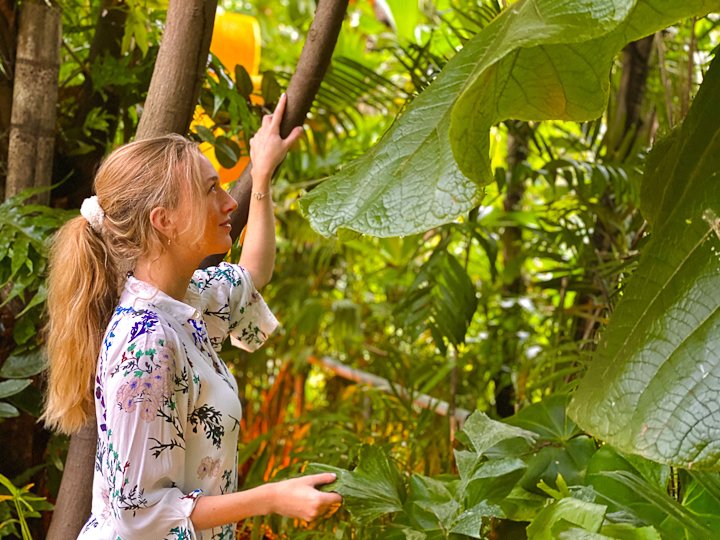





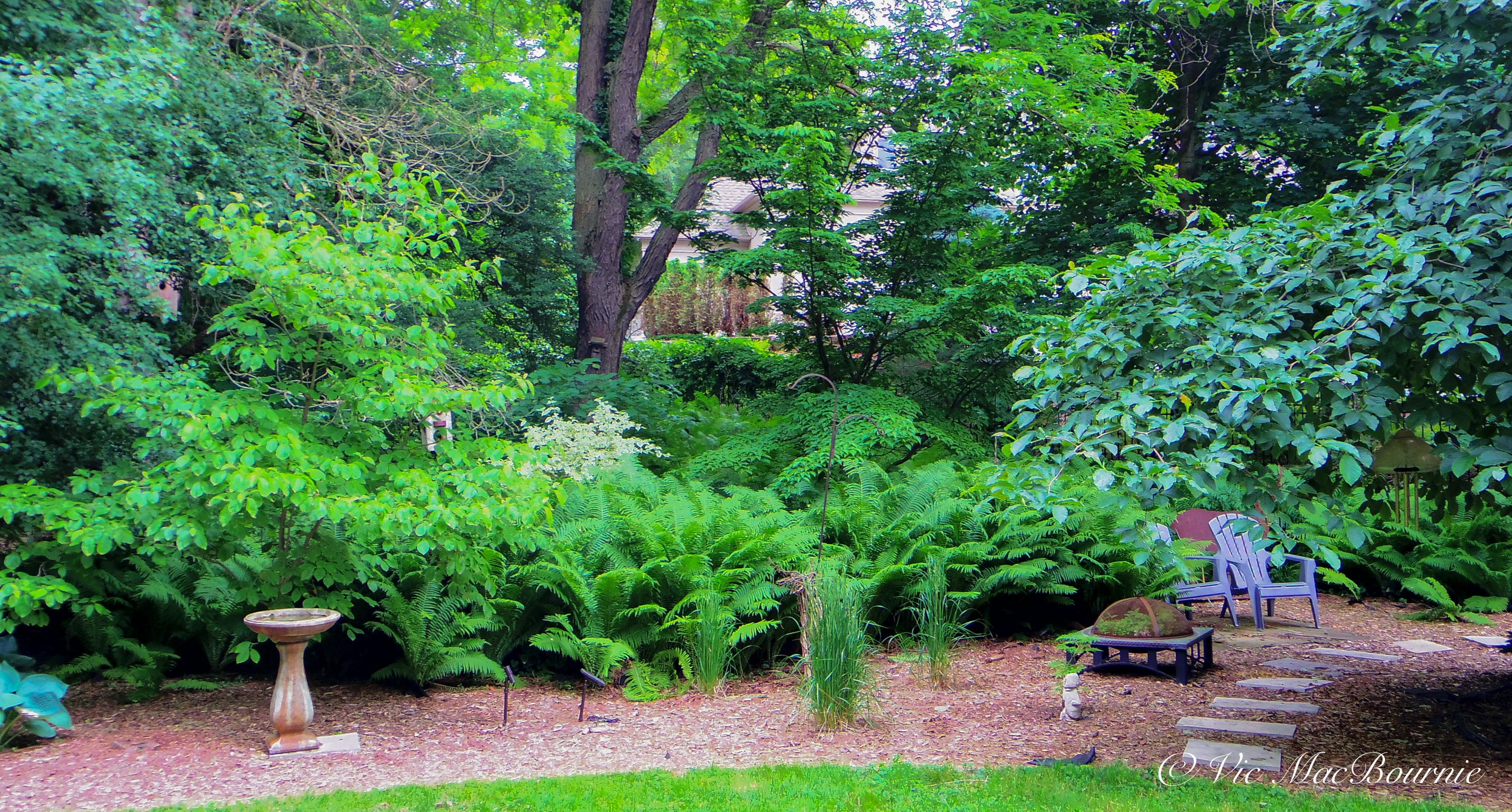

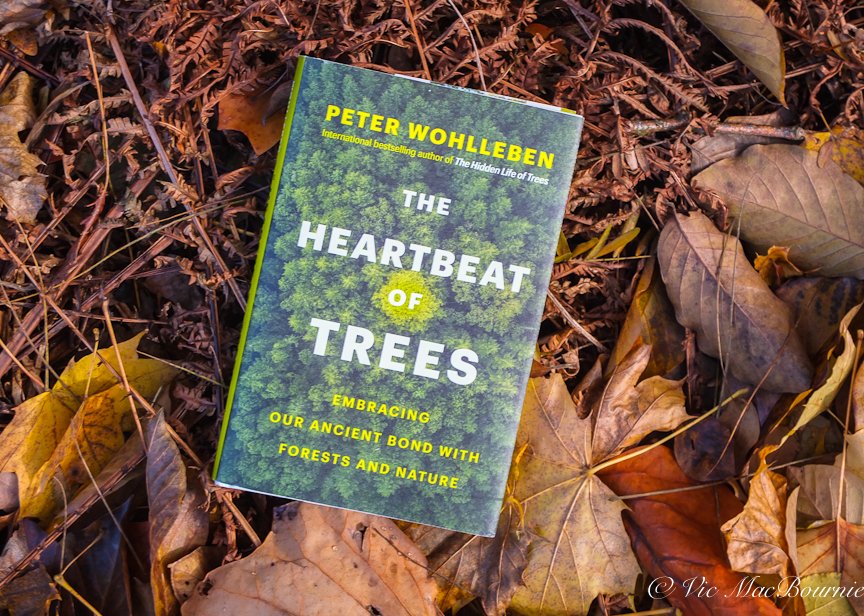

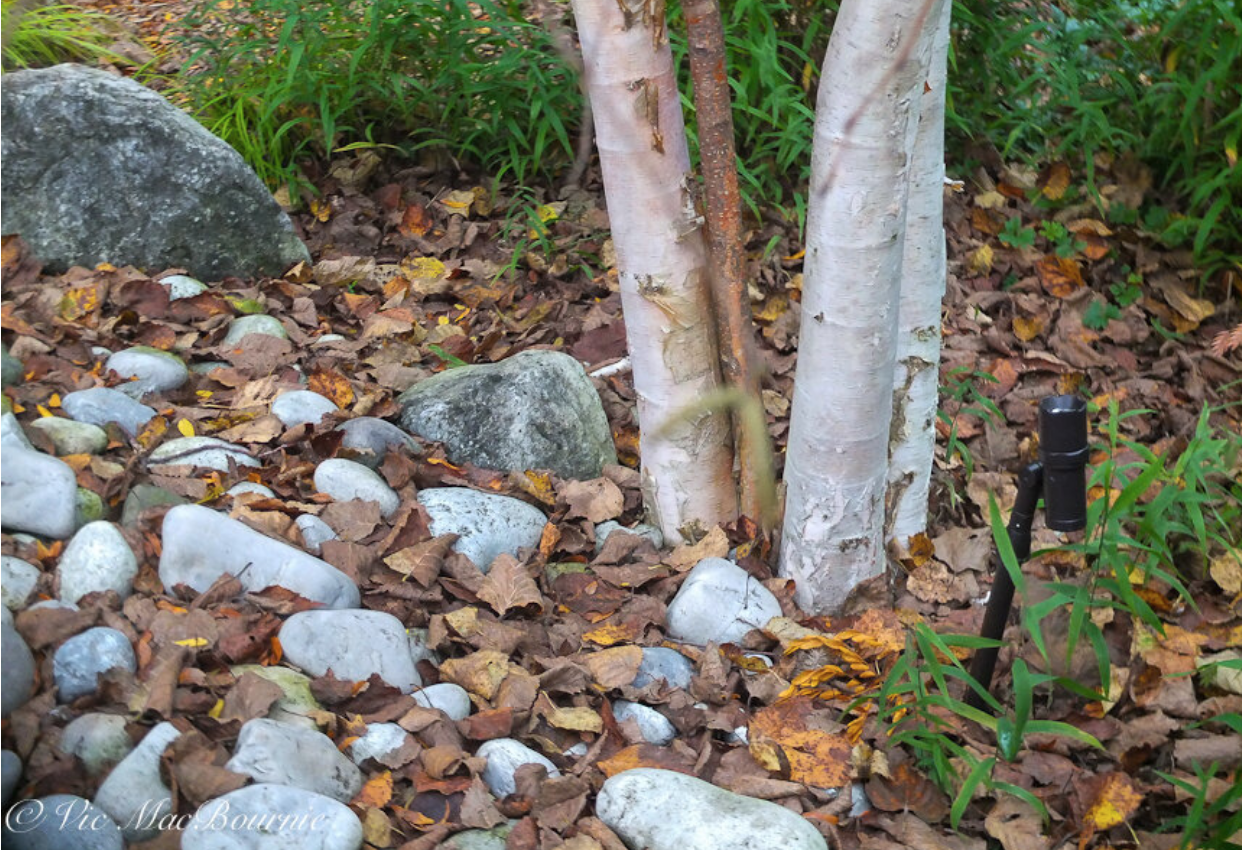
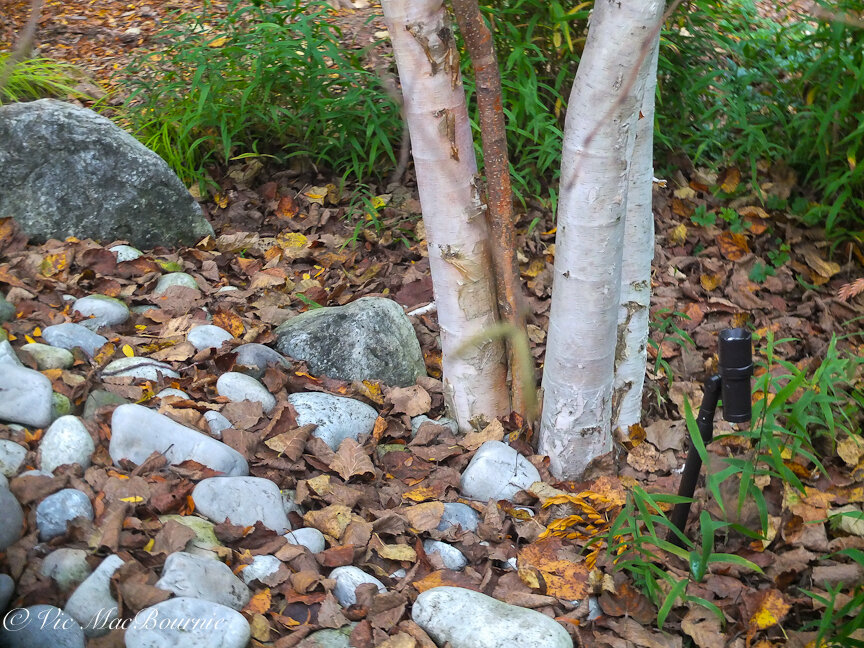
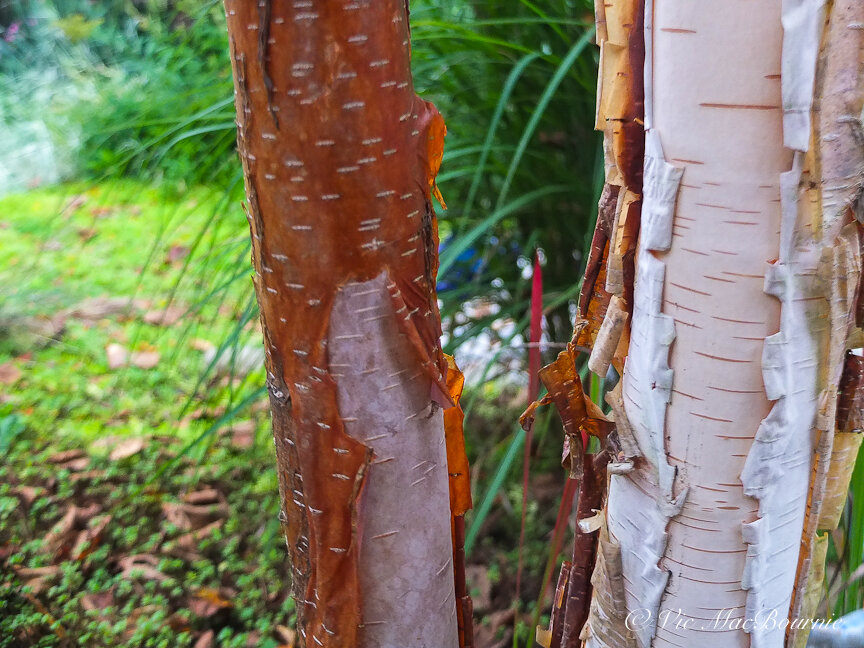
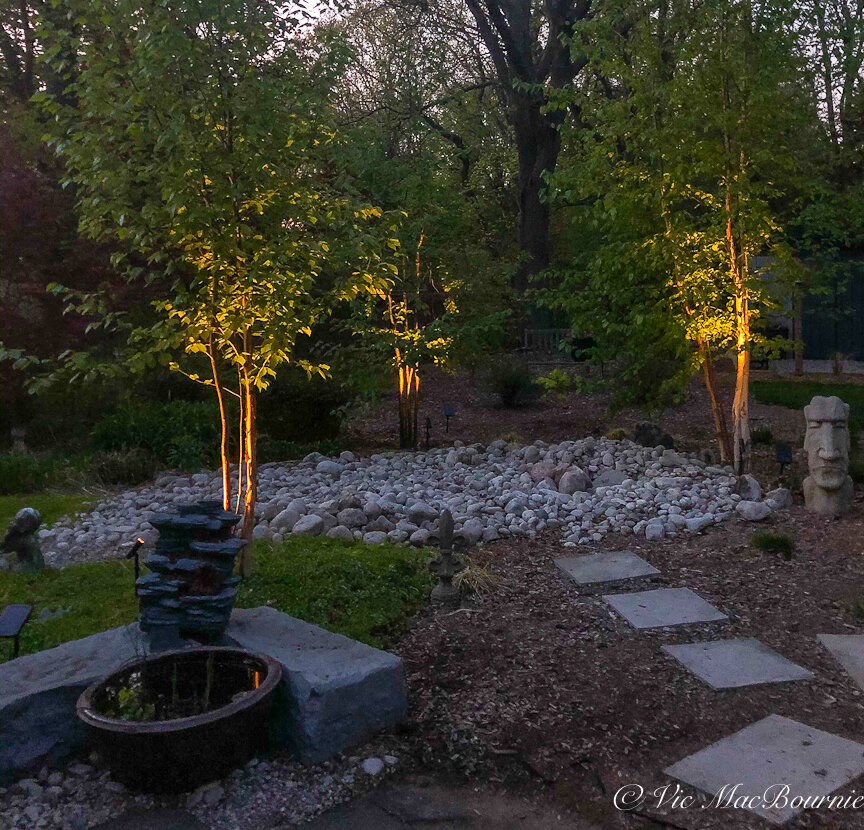
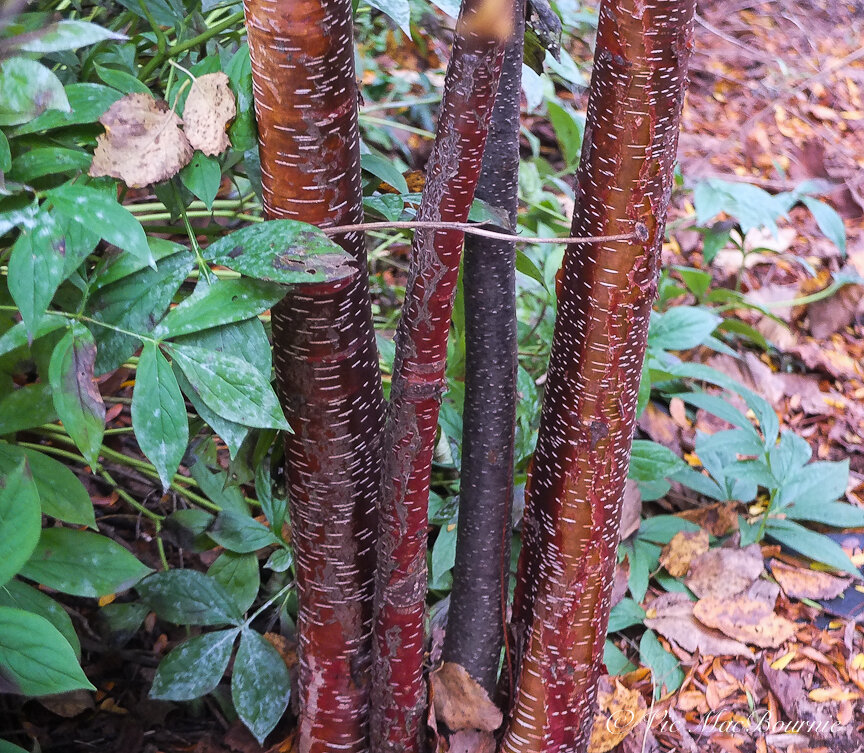
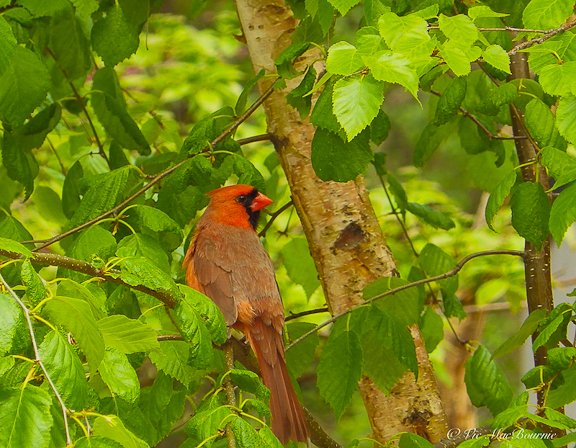
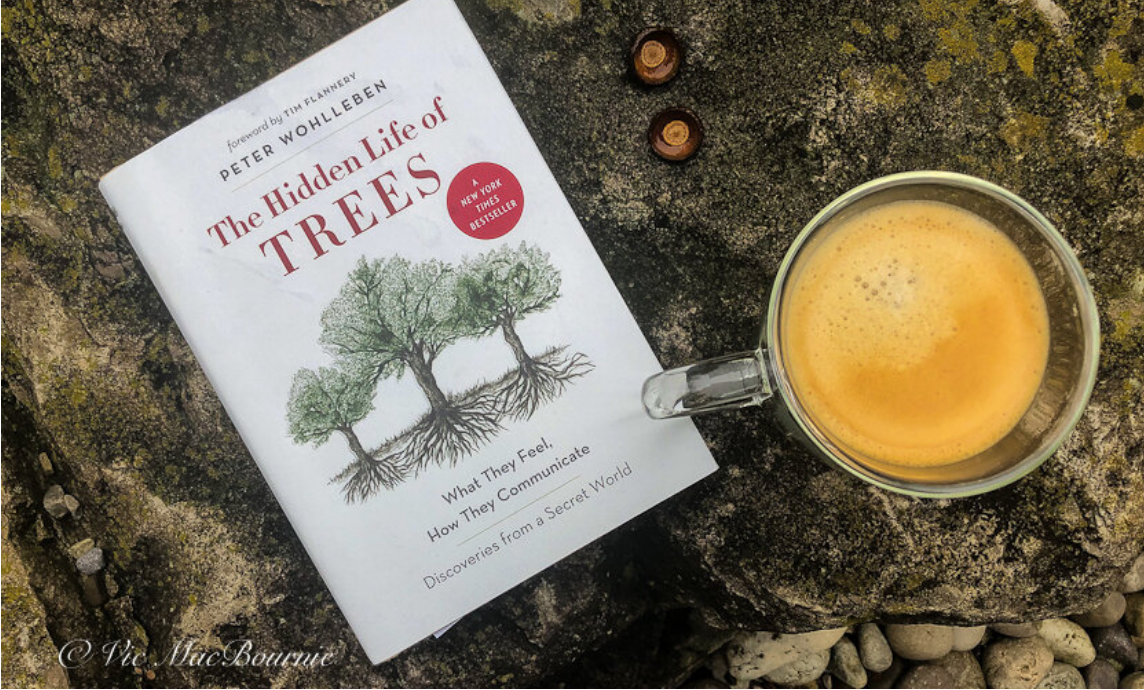
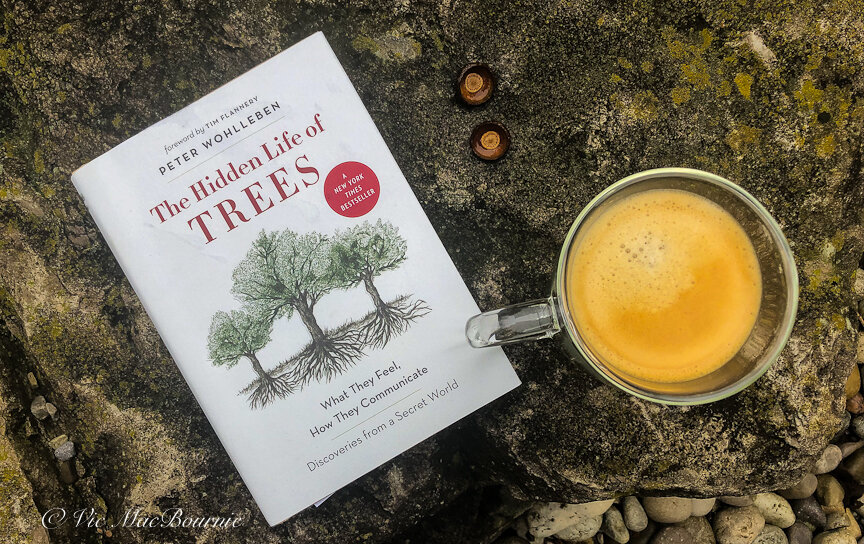
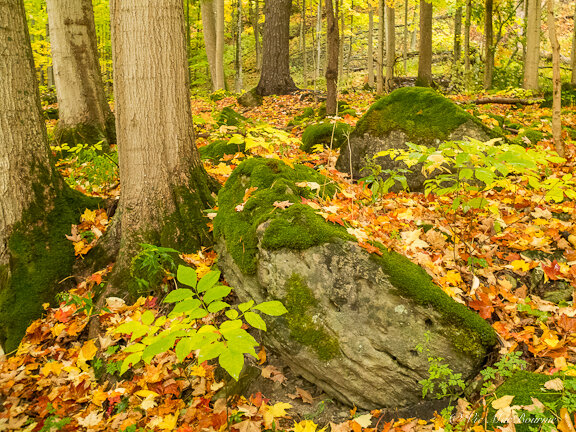

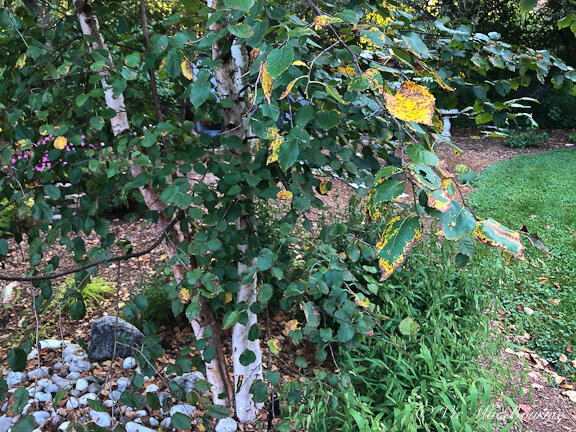






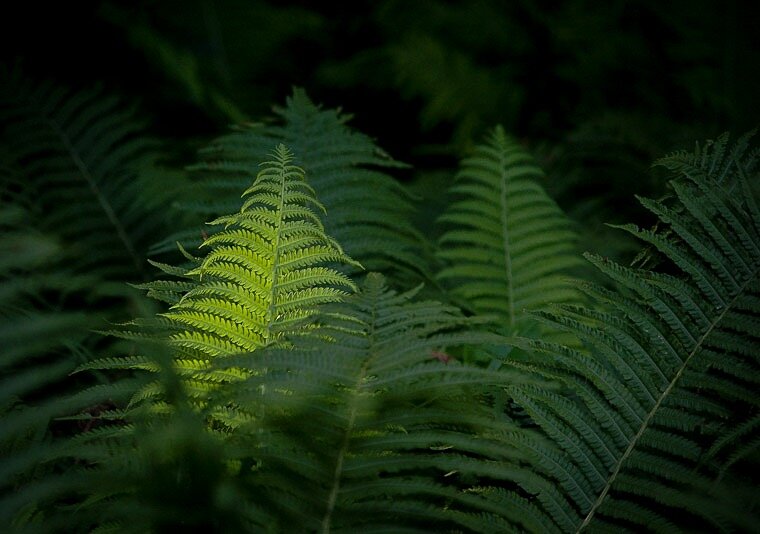


Creating a woodland/wildlife garden using native plants has many benefits including being able to photograph the wildlife that lives in and visits your backyard.